Like all forms of body modification, the art of piercing has evolved. Getting one’s ears pierced is common no matter your gender or age, and nobody blinks an eye at the site of a nostril, a bellybutton, an eyebrow or even a lip ring these days, though the latter three might seem a bit dated to older folk, visually tied to the early ‘90s punk and metal heyday when they became most popular and were seen all over album covers and MTV.
A new generation has discovered body jewelry and adornment, and it’s not even a retro thing. Fans of goth aesthetics and fashion hubs like Dolls Kill, Killstar, and the like, have re-ignited a new piercing culture. With celebrities like Demi Lovato and Miley Cyrus rocking them, they’re practically mainstream. The hashtag “piercings” has 14.7 billion views on TikTok.
Recently, this writer’s own teenager requested to move beyond earlobes to the cartilage between their nostrils – the septum – and our reaction wasn’t exactly that of a “cool mom,” despite the fact that we happen to be tattooed and have multiple holes in our own ears. For many, facial piercings go too far, even today. They may not exactly be job killers anymore, but faces are focal points and, depending on the size of the jewelry, it can still be distracting. For others, especially in South Asian cultures, it’s commonplace and represents social status and a coming-of-age, signifying womanhood. In India, nose piercing is simply tradition.
Once we came to a compromise – two piercings: one nostril, and an upper ear – and we had to decide where to go. Piercing parlors aren’t as prevalent as they once were in Los Angeles, and mall piercing stations at places like Claire’s Accessories are extremely risky and more painful than the alternatives.
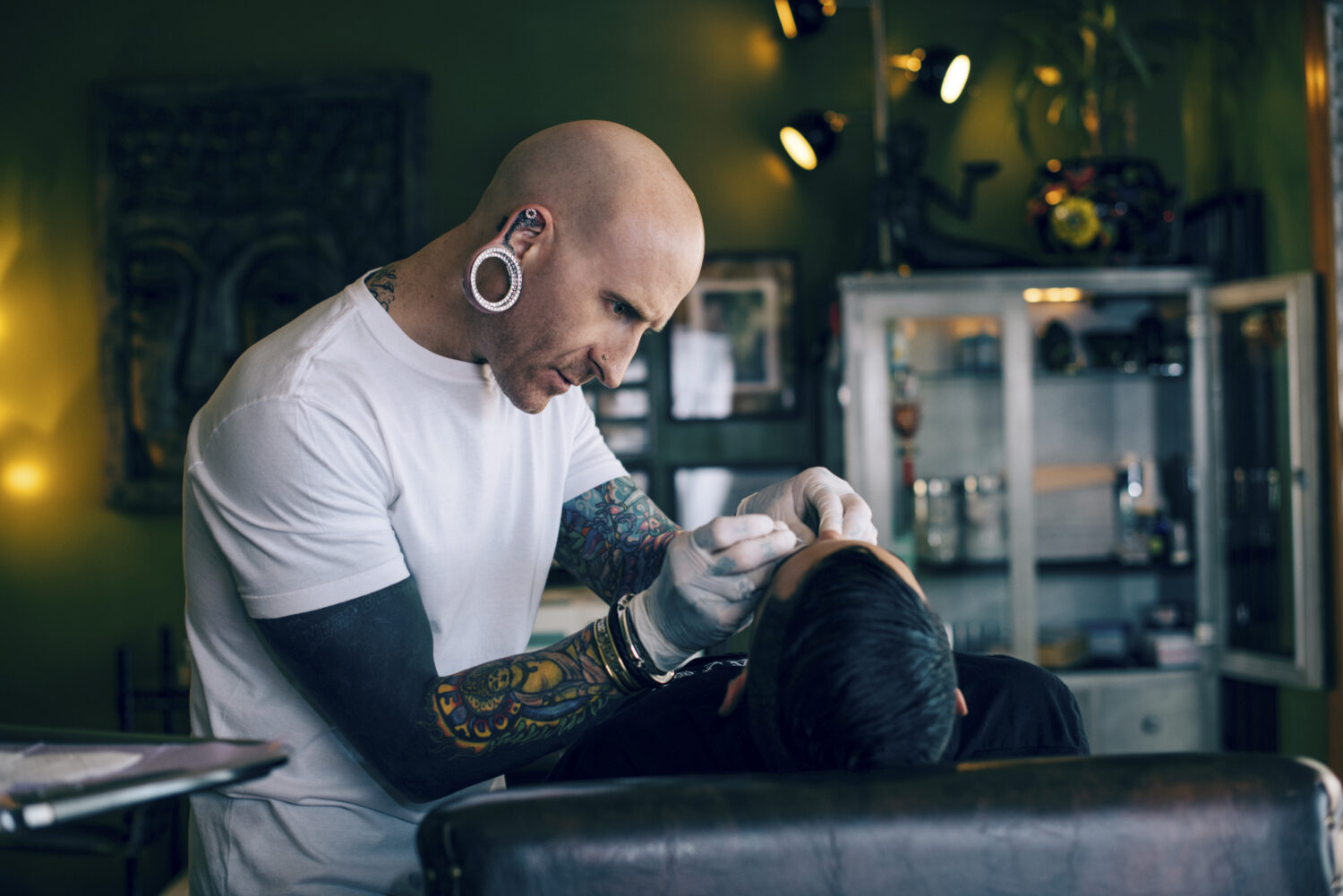
(Courtesy Body Electric)
For safety and quality, a little research was in order. Google “best in piercers in L.A.” right now and one name comes up again and again: Brian Keith Thompson at Body Electric on Melrose Ave. Thompson is the proprietor and “chief piercing officer” at the second-story shop, which for many years was best known just for its tattoo work. We got our first piece of ink there in fact, so coming back would be a full-circle experience. While Thompson and Body Electric have gained attention for a consistent celebrity clientele (he is touted as “Beyonce’s piercer” by name-driven publications and tabloids), the longtime Angeleno also is known for his soulful, communicative approach to the art of piercing, which is anything but pretentious or celebrity-seeking.
When we arrived at the Melrose studio, Thompson was talking with a mother and her two young daughters, both of whom wanted to get “constellation piercings” – the term coined for his artful stars-in-the-sky-like ear designs, which usually feature clusters of tiny studs, gems and delicate hoops running from the bottom of the lobe all the way up to the top of the ear, each section with a different name: the daith, the helix, and the orbital, being just three of them.
We opted for an “industrial” ear piercing, which runs through two points of cartilage on top of the ear, and the aforementioned nostril. Thompson talked about what he was doing as he took a large needle and pushed through the skin and flesh in a calm, relaxed manner that made everyone feel comfortable. It was over quickly, with minimum wincing, flinching or blood.
Next comes the healing stage, and if you’re thinking of getting pierced, please note: It takes attention, a lot of daily care and can involve swelling and irritation, as the body adjusts to the wound. Even so, as is often the case after one’s first body modification, our kid is already itching for more.

(Courtesy Body Electric)
Bars and Barbells
Brian Keith Thompson came to Los Angeles from Texas at the age of 12, after his parents divorced in 1984. “I was always just different. I looked different, I thought differently,” he recalls. “So I moved here with my dad I finally felt free to be who I wanted. But then I got here and I was bullied. The problems didn’t go away. I had long hair back then, listened to metal, and I was called hesher. In eighth grade, the kids picked me up at lunch and threw me in a trash can in front of the whole school. It just sucked, constantly getting messed with and beat up. So I just kind of retracted. I always said that one day, I’m gonna make these people see what I’m made of.”
Thompson was suicidal as a teen, until he met a new friend at a local Target. The guy he called his mentor ultimately introduced him to cholo culture and gangs, which gave him the sense of belonging he craved. It was both a good and a bad thing. He started hanging with the mostly Latino Canoga Park Alabama Street gang, who referred to him as “gaba,” short for “gabacho,” a term often used for white people.
“These people were like brothers and it was like being in the military, too – there was a rank structure and a respect level. I was a part of something that had a functional base to it. And it made me feel powerful,” he says.
But eventually, he was in the wrong place at the wrong time and it got him pinned with a murder charge. He was at the scene of a shooting, though he didn’t pull the trigger. In 1998 he went to jail for two years, but ultimately fought the case and got out.
Thompson had worked at his father’s tech company and been in the Marines prior. He was smart and determined. Once he focused on getting out of jail, he made it happen. Though he says it was hard to be white in L.A. county at that time, he made friends. Forced to choose an allegiance, as most inmates are, he joined the white gang, “the Woods,” out of sheer self-preservation. He got a job serving food to the inmates in super-maximum and would sneak extras for everyone, forging connections and earning respect.
“When I got out, I heard, ‘see you assholes next month,’ and it’s a guy in the tower looking down (at me). And I said, ‘no, sir, you will never see me again.’”
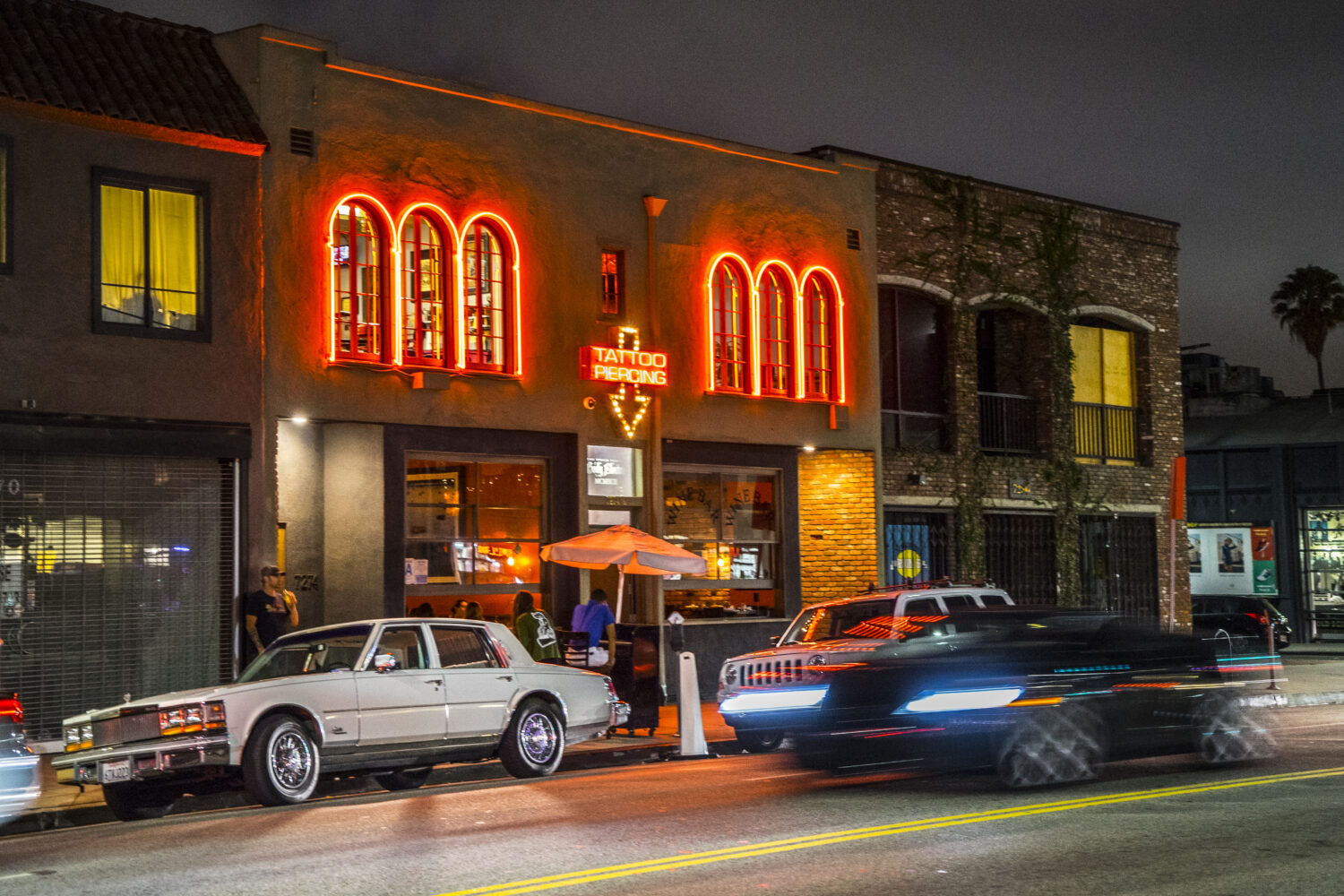
(Courtesy Body Electric)
Though he says, in some ways, prison was “the best thing that ever happened to me,” he was focused on moving on once released. He started getting the gang and prison ink he’d acquired covered up with new art, which led him to the famed Body Electric tattoo on Melrose. He “became obsessed” with getting work done even as he was still working at his dad’s company, making money and saving it, as he hid his tattoos under his business suits.
Before the stock market crash of 2008, Thompson cashed out his 401k and bought the shop, set on connecting with people in new ways and revitalizing tattoo and piercing culture in Los Angeles. He’s done just that. Body Electric is now known globally for both its ink work and piercing services, and Thompson hopes the place will remain a local landmark once he’s gone. He’s been renovating and remodeling the building for the past few years, putting in new Deco and vintage touches like marble and fixtures from historic L.A. landmarks. The shop is gleamingly beautiful, clean and classy. You walk in and you just know you’re in a quality spot.
“I wanted to make it a friendly place, more customer-oriented, so that no matter who you are, you don’t have to feel intimidated to walk in,” Thompson says. “ I also wanted to show a finer side of it. I didn’t want all that tribal stuff anymore. I like diamonds and gold and fine jewelry.”
Thompson’s presence and personal style only add to this vibe. Dressed in stylish suits and pristine sneakers – his signature look – he also has a shaved head and an array of iced piercings, including stretched earlobes that shimmer under overhead lighting and in the sunshine that beams into the shop from large windows overlooking Melrose Ave. This is an elevated piercing environment that’s also quite relaxed and welcoming, for famous people (he pierces in a private backroom), for alternative types, and for families.
Thompson got into getting heavily tattooed in 2001, and he got into piercing in 2006. But he had always been fascinated by both. “One of my favorite movies was Pulp Fiction,” he recalls, about what first made him think seriously about the art of piercing. “That whole scene where John Travolta asks about piercing guns when he gets his drugs and (Rosanna Arquette) says how guns go against everything it’s about… Then he talks about ‘all the shit in her face,” and (Eric Stoltz)] says, ‘that’s Judy, my wife.’ That scene is burned in my brain. And then I became a fucking piercer. That’s just so weird to me.”
Throwing Down the Gauntlet
While Thompson has forged his own path in the world of piercing, we’d be remiss if we didn’t give a nod to the groundbreaking figures of the past who turned piercing into a bona fide movement, especially as they were based right here in L.A. The Gauntlet, founded by master piercer Jim Ward in the late ‘70s, was the first business of its type, with an original location in West Hollywood on Santa Monica Boulevard, followed by shops in San Francisco, New York, Seattle and even Paris.

(Courtesy Body Electric)
Though piercing first emerged from queer and BDSM communities in Southern California and gained traction with the popularity of the modern primitive movement (as seen in the iconic Re:Search book Modern Primitives: Tattoo, Piercing, Scarification) it quickly grew and became popular with all kinds of people who steadily had more and more jewelry and designs to choose from, including different gauges (thicknesses) and of course, places to pierce. As the Gauntlet piercers and those who learned from them became more popular, the public became more educated, too. The safe, professional practices in place led to the popularity of more intimate body parts (nipples, tongues and genitalia, for example) for many.
“Its primary focus was on body piercing as a way to enhance sex,” says the Gantlet’s owner and recognized pioneer of piercing Jim Ward tells LA Weekly. “In those days, we did a lot of nipple and genital piercings. Things have changed dramatically since then. Gauntlet may have created an industry, but the focus these days is primarily on piercings above the neck and for cosmetic purposes.”
“Today’s standards for techniques, tools, jewelry designs, and ethos, shared by the most advanced practitioners, nearly all trace their roots back to the Gauntlet,” adds Paul King, a master piercer who worked for Ward in all three former Gauntlet locations and later went on to open his own space Cold Steel in SF. “The modern body piercing industry rose from the foundation developed by (Jim) and spread by masterfully skilled piercers such as Elayne Angel.”
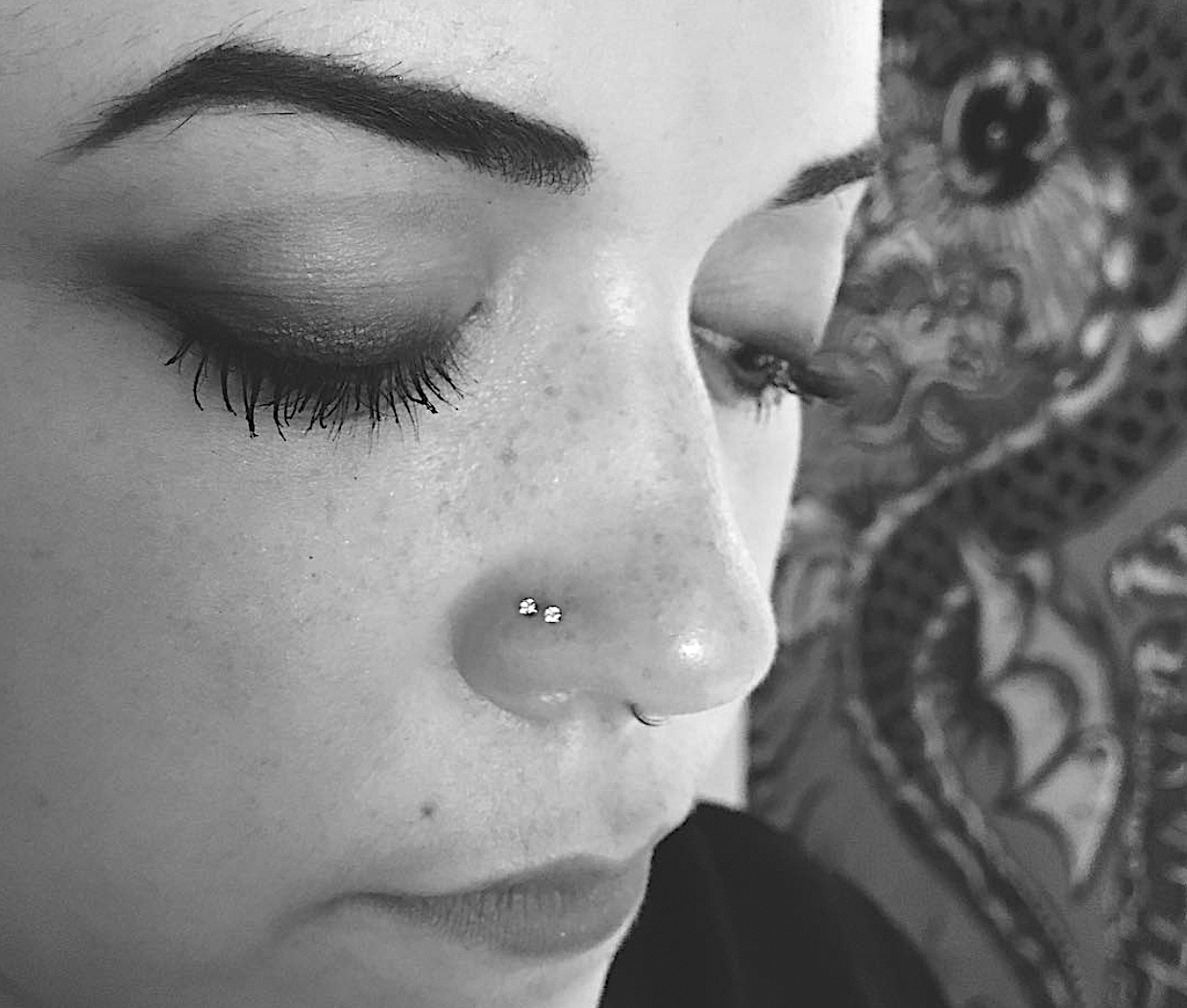
(Courtesy Body Electric)
Angel, the first person to be certified as a Master Piercer at The Gauntlet, literally wrote the book on the practice, The Piercing Bible– a tome Thompson recommended we read for research. It features information on everything you’d ever want to know about piercing. “When I was a Gauntlet client in the early 1980s and became manager there later in that decade, body piercing was not yet an accepted part of modern culture,” she says. “Piercing was an obscure fringe activity, and people thought we were freaks, weirdos and perverts. It was so different, it is hard for younger people today to even imagine the shock and disgust onlookers often displayed when confronted with body piercings back then.”
“There was a tremendous sense of newness and adventure when the field was still in its infancy,” she continues. “Piercing had yet to become an industry. That was a period of experimentation and innovation, including trials and errors. We learned a lot about what not to do, along with our successes. It was a truly exciting era that I recall fondly. Though my family was far less enthusiastic about my career choice; they’d never heard of a “professional piercer.” Eventually, they came around, and they’re now proud of me for my role as a pioneer in the field. Nowadays, everyone knows that piercing exists, and it has become an option that nearly anyone might exercise.”
Both Angel and King highly recommend Ward’s book Running the Gauntlet (and its accompanying website (runningthegauntlet-book.com) as an essential resource for anyone interested in piercing culture. For more background and history check out King’s Body Piercing Archive (bodypiercingarchive.org) and Angel’s book site (piercingbible.com/the-piercing-bible-book).
Stars and Studs
While piercing is no longer necessarily an outsider thing, it still gives a little edge to anyone who chooses do it. Rihanna (a Thompson client) has proudly shown off her nipple piercing, which surely inspired copycats and normalized the practice. Thompson and Body Electric get the most attention media-wise thanks to the celebrity angle, but he’s built a strong community fan base as well. Like most practitioners with close client relationships, he is not a name-dropper. His longtime client list is out there on the web, though, and in addition to RiRi, it’s stellar to say the least: Queen Bey, as well as Christina Aguilera, Angelina Jolie and most recently Doja Cat, just to name a few. Scarlett Johansson (pictured below) came to him for jewelry design and placement.
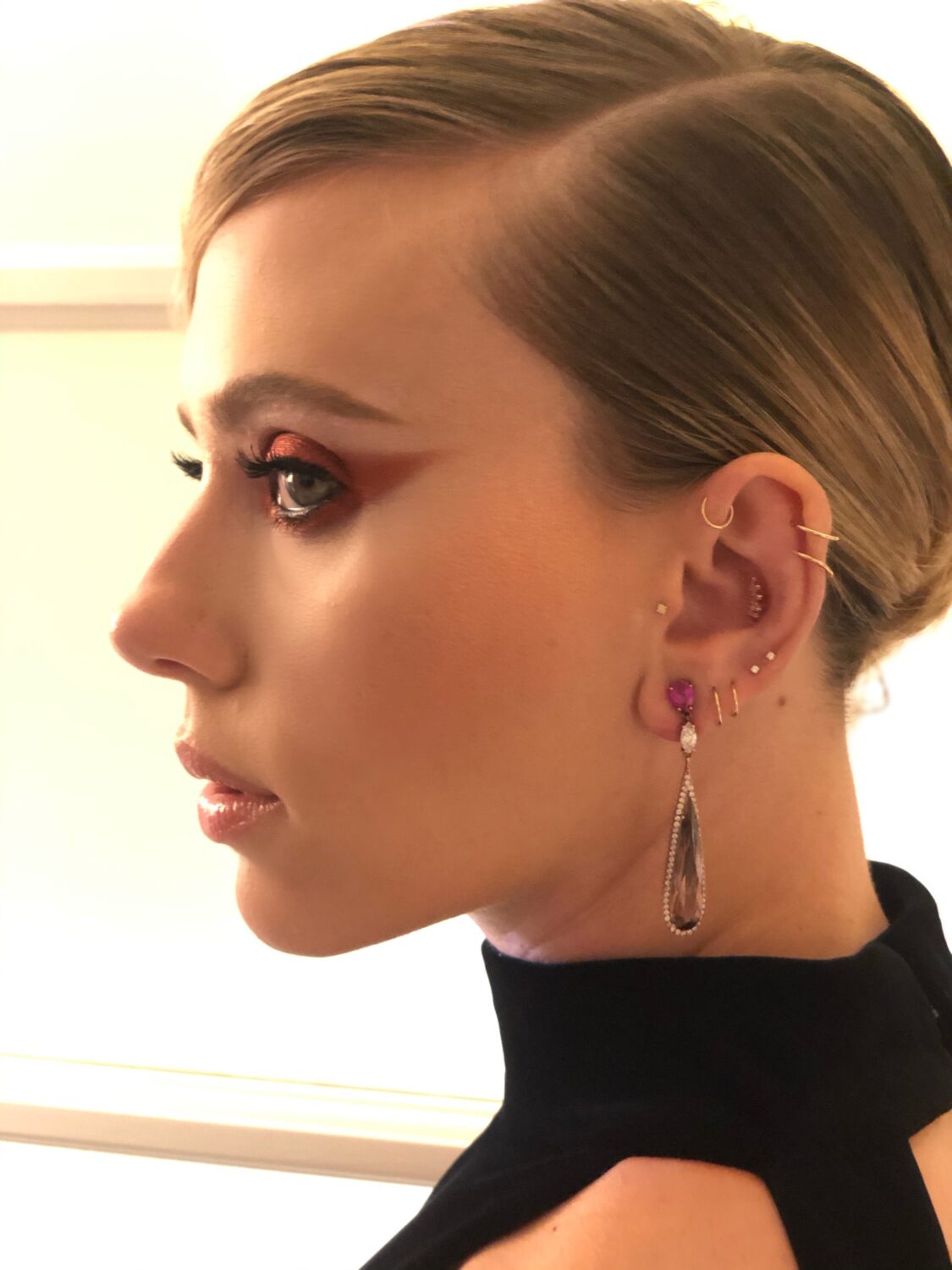
(Courtesy Body Electric)
Visiting the shop (which still offers an array of tattoo artists up front and a piercing studio in the back) has become popular content for influencers not only due to the star power, but also Thompson’s eye-catching star-like placement style, especially on ears. Other shops and piercers have tried to copy his popular constellation designs, but he’s the recognized standard, taking an artful approach not only to where, but to what – choosing various weights and shapes that adorn each ear, nose and body part he works on. He might not be the cheapest, but when puncturing one’s face and body, who really wants to skimp? You get what you pay for. And just like the L.A. pioneers of the past, he is moving the art of piercing forward.
“When I started here I wanted to show a finer side of piercing,” Thompson tells us, as we finish up our kid’s session and a truly engaging conversation. “I wanted do something fresh and new. You know, when I got into this business, everyone said ‘you can’t make money in the tattoo/piercing business anymore.’ I’d tell them ‘yeah, you’re right, ‘you’ can’t, but watch me because I will not stop.’ When I am into something and want to do something, I will just master what I love every day. I will outwork everyone. And I will give each client the same intensity in the first five fucking minutes that I get here, as I do the last five minutes before I leave. I give everybody the same and they feel it. It’s part of the experience.”
Body Electric, 7274 Melrose Ave., 323-954-0408. bodyelectrictattoo.com
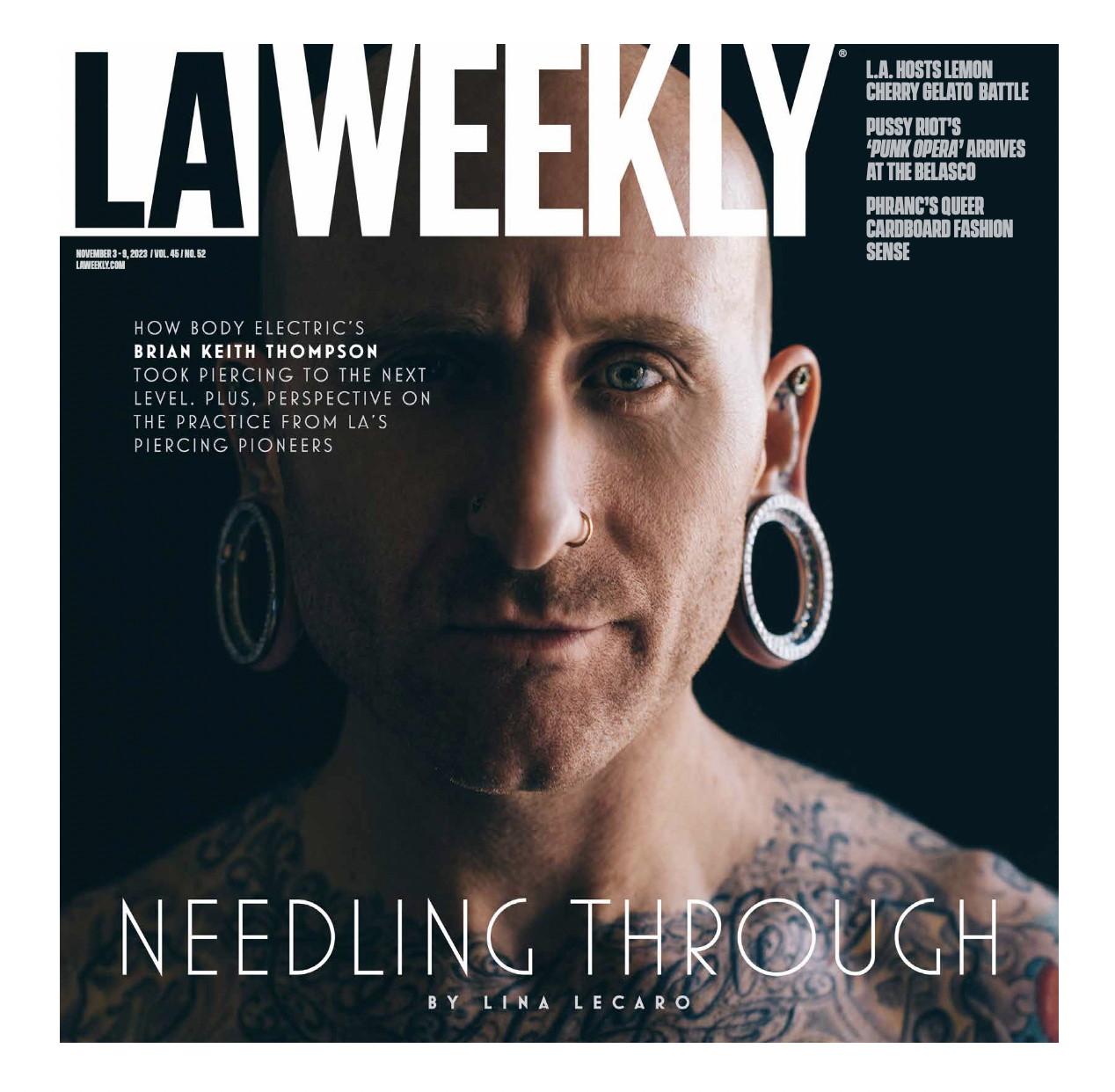
This week’s LA Weekly cover story.
Editor’s note: The disclaimer below refers to advertising posts and does not apply to this or any other editorial stories. LA Weekly editorial does not and will not sell content.
Advertising disclosure: We may receive compensation for some of the links in our stories. Thank you for supporting LA Weekly and our advertisers.

